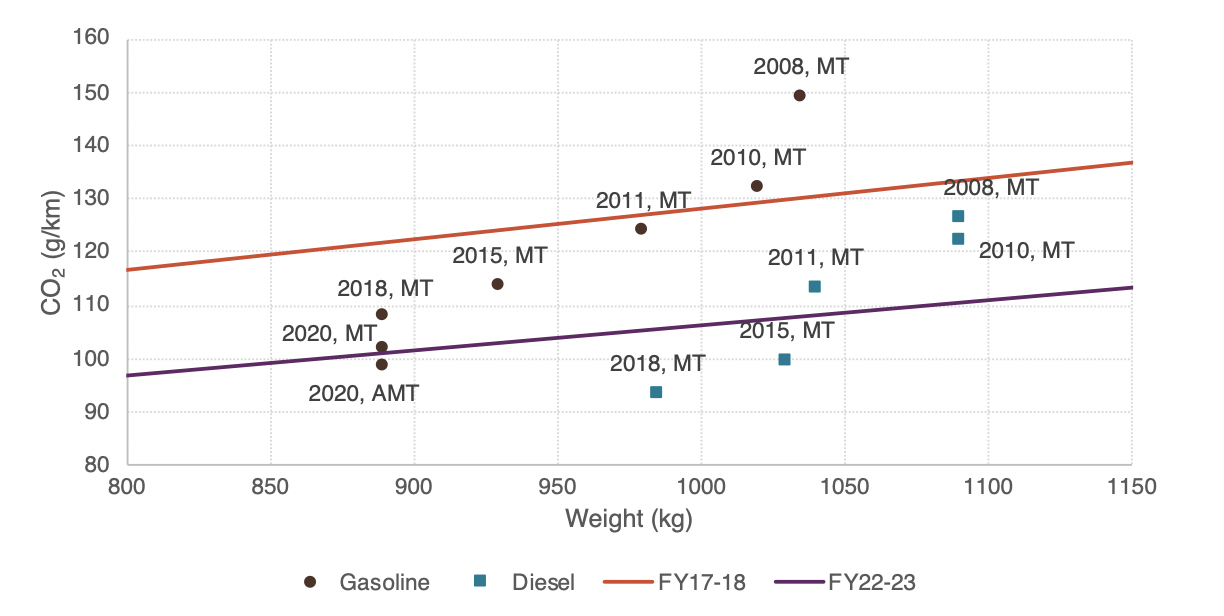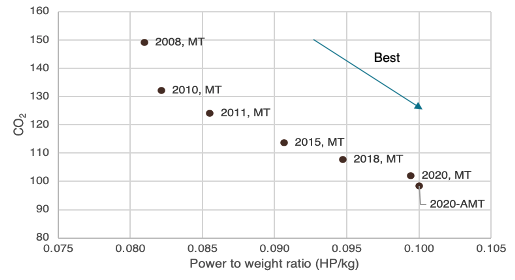At the end of 2019, Maruti Suzuki’s Dzire reached a rare milestone for passenger cars in India when cumulative sales surpassed 2 million units. Launched in 2008, this now-coveted vehicle has come a long way to claim the title of best-selling compact sedan in India. It’s also one of the most fuel-efficient vehicles in Maruti’s stable and that is almost certainly no coincidence. The technologies it uses are helping Maruti meet India’s fuel consumption standards comfortably, but the Dzire’s technological evolution over the past decade is also worth studying because it illustrates that India’s fiscal year (FY) 2022–23 fuel consumption targets can be met without advanced technologies such as hybrids and electrics.
The first generation Dzire was more than 4 meters (m) long and had a 1.3-liter (L) gasoline engine with a 5-speed manual transmission. In 2009, when Maruti first declared the fuel efficiency of its vehicles as a part of the Society of Indian Automobile Manufacturers’ Voluntary Labeling Program, the Dzire’s gasoline fuel efficiency was listed as 15.9 kilometers per liter (kmpl), which equates to 149.1 grams (g) of CO2/km, with 1,035 kilograms (kg) curb weight. Today, the 1.2L K12N Dualjet-powered gasoline vehicle is 3.995 m long with a curb weight of 890 kg and fuel efficiency of 24.1 kmpl (98.3 g CO2/km) in its automated manual transmission (AMT) version. The engine, which has 6% more power and weighs 14% less than the engine 12 years ago, provides a 34% reduction in CO2 emissions. Figure 1 shows the evolution of Dzire in terms of curb weight and CO2 emissions with every new launch from 2008 to 2020. The solid lines represent the fuel consumption standards for FY 2017–18 and FY2022–23. (As shown, the diesel trim has also improved over time, but as Maruti has temporarily discontinued it, we focus on gasoline technologies here.)

Figure 1. Evolution of the Dzire compared to fuel consumption standards.
How does the lighter weight improve the Dzire’s fuel economy? It means less vehicle inertia, reduced parasitic rolling resistance losses, and faster acceleration. During laboratory testing, the vehicle is driven over a chassis dynamometer, which has standard inertias available to emulate the vehicle weight. A rough estimate is that a shift to one lower inertia class can give 3.7% CO2/km improvement. Note, however, that as Peter Mock explained here, the use of inertia classes for laboratory testing means the benefits on the test cycle can sometimes be higher than in the real world, depending on where in the inertia class the vehicle falls. For rolling resistance parasitic losses, a rough estimate is that 14% of mass reduction improves CO2/km by about 2.8%. Finally, less weight means less effort by the powertrain to pull the vehicle and faster acceleration. It is estimated that the same mass reduction can improve CO2/km by about another 2.8% if the additional acceleration is sacrificed for a smaller engine and/or longer gear ratios. Thus, a 14% mass reduction gives a cumulative benefit of about 9% improvement in CO2 emissions and fuel consumption when measured over a standard test cycle. To achieve mass reduction, engineers employed multiple methods, including shape optimization, usage of high strength steel, aluminum, and plastics, and reducing the thickness of materials used in the vehicle. Dzire achieved the feat of lightweighting even when stricter safety norms of crash testing were put in place at the end of 2017.
Apart from lightweighting, additional technologies were used to improve fuel efficiency. Primary among them is engine friction reduction. Initial versions of Dzire used 15W40 engine oil, which has high viscosity. Today, Dzire uses 0W16, and this transition over 10 years likely improved efficiency by 7%–8%. Additional benefit was also realized from thinner transmission oil, though the impact is on lower side at about 2%–3%.
On the engine front, in 2010, the gasoline trim got upgraded with K12 engine with fuel efficiency of 17.9 kmpl (132.5 g/km). Subsequently, in 2011, the engine was further upgraded with variable valve timing (VVT) technology on intake valves and calibration improvements that reduced the fuel consumption by 6.7% to 19.1 kmpl (124.2 g/km). Later, with Dualjet technology, it became the most fuel-efficient engine in India. This 1.2L K12N engine incorporated technologies like friction reduction, cooled exhaust gas recirculation, piston cooling jets, high compression ratio, and dual VVT technologies. Figure 2 shows the progress of power to weight ratio and CO2 with every new launch of Dzire over the past 12 years.

Figure 2. Power to weight ratio versus CO2 of all Dzire variants.
Regarding transmission, Dzire has a 5-speed manual version and Maruti made tall 4th and 5th gears whenever it ventured into mass reduction. In 2016, Dzire launched an AMT trim for its diesel vehicle. AMT has an added benefit when compared with manual trims in that it helps the engine control unit keep the engine operating in more efficient zones. A computer controlled automatic transmission with improved efficiency was added to Dzire gasoline models in 2020. New Dzire models also have improved aerodynamics, with the coefficient of drag reduced to around 0.32–0.33. Maruti also added a start-stop and regenerative braking system that improved the fuel economy by 8%–9%. Most of the vehicles in Maruti’s fleet, including Dzire, are based on a new-generation HEARTECT platform that is designed to meet stricter safety norms. Using computer aided engineering, high strength steel, and physical crash testing, the platform has been designed for high-impact absorption in case of collisions while negating any impacts on weight.
The vehicle has become wider over time. When launched, it was 1,690 mm wide and had a 2,390 mm wheelbase. This has increased to 1,735 mm wide and a 2,450 mm wheelbase and means no compromise in terms of passenger comfort, as the vehicle has become more spacious. Amazingly, all of these technology infusions and comfort-centric designs did not result in an increase in price. On the contrary, inflation adjusted prices have decreased, even as today’s Dzire is loaded with far more infotainment features than earlier versions. New engines have upgraded hardware, software, and emission control systems that are compliant with Bharat Stage VI standards. Additionally, enhanced safety features such as dual airbags, antilock brakes, and a child seat restraint system are provided as standard.
So, can India’s fuel consumption targets for FY 2022–23 be met without advanced technologies such as hybrids and electrics? Looking at Dzire’s case study, the clear answer is yes. The present generation of Dzire is already more efficient than FY2022–23 standards, even without the smart hybrid system that could further increase efficiency by 3%–4% if a 12V hybrid system is used or by 5%–8% if a 48V hybrid system is used. Today, Dzire and models on similar architecture constitute 40% of Maruti’s total sales by unit volume. With all the technologies included, there will be a good margin of 5%–6% with respect to FY 2022–23 standards. Dzire’s case study shows that incremental technologies in mass-selling, low-priced vehicles can become a key to achieving the FY 2022–23 fuel consumption targets.
SOURCE: ICCT
"consumption" - Google News
November 03, 2020 at 02:47PM
https://ift.tt/2HQYMax
ICCT: Every manufacturer's “Dzire” for meeting PV fuel consumption standards in India - Automotive World
"consumption" - Google News
https://ift.tt/2WkKCBC
https://ift.tt/2YCP29R
Bagikan Berita Ini














0 Response to "ICCT: Every manufacturer's “Dzire” for meeting PV fuel consumption standards in India - Automotive World"
Post a Comment